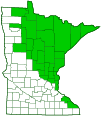running clubmoss
(Lycopodium clavatum)
Conservation • Wetland • Description • Habitat • Ecology • Use • Distribution • Taxonomy
Description |
||
There are 76 species of Lycopodium worldwide. Only two of them occur in Minnesota. Running clubmoss is very widespread and common. It has a worldwide distribution, occurring on every continent except Australia and Antarctica. In the United States it occurs from the northeast to the upper Midwest, south along the Appalachian Mountains to Georgia, in the northwest, and on the West Coast. It is common in Minnesota in the Arrowhead region, infrequent in the north-central and central regions as far south as the northern metro, infrequent in the driftless area in the southeast, and absent from the remainder of the state. Running clubmoss is an evergreen, perennial club moss. It produces a very long, creeping, horizontal stem (rhizome) and clusters of upright stems. The rhizome can be up to 39″ (1 m) long and lies mostly flat on the ground, sometimes under the duff layer, but never beneath the soil surface. It is densely covered with small leaves. It is branched and the branches interlace, often forming dense colonies. Roots emerge at long intervals from the underside and upright shoots at shorter intervals from the upper side. Upright shoots are leafy, round in cross section, 4″ to 10″ (10 to 25 cm) long, 3 ⁄16″ to ⅝″ (5 to 15 mm) in diameter including the leaves, and have 3 to 6 lateral branches. They are not tree-like. The branches are of various lengths, are similar to the main shoot, and rise at an angle (oblique) or are nearly horizontal (spreading). Most are on the lower half of the upright shoot. Many are branched again into two or more somewhat spreading branchlets. The branches and branchlets have abrupt narrow areas with smaller leaves that mark the start and end of each year’s growth (annual constrictions). The rhizome, shoot, branches, and branchlets are all densely covered with small leaves arranged spirally in 12 to 20 ranks. The leaves are stalkless and mostly spreading but those at the upper third of the branches are often somewhat curved up from the base (ascending). The leaf blades are medium green, long and narrow with straight sides (linear), ⅛″ to ¼″ (4 to 6 mm) long, and 1 ⁄64″ to 1 ⁄32″ (0.4 to 0.8 mm) wide. They are sharply pointed and have a 1 ⁄16″ to ⅛″ (2.5 to 4.0 mm) long hair-like tip. The margins are untoothed. A single stalk (peduncle) rises at the end of one or more of the branches on fertile shoots. The peduncle is 1⅜″ to 4¾″ (3.5 to 12.5 cm) long and is covered, at least on the upper portion, with appressed leaves arranged in pseudo-whorls. It usually has 2 to 5 loosely alternate, 3 ⁄16″ to 5 ⁄16″ (5 to 8 mm) long branches (pedicels) with a single cone-like, spore-bearing structure (strobilus) at the end of each pedicel. The branches are arranged in a straight central axis with side branches – it does not appear forked. Within any population there may be one or more plants with just a single strobilus. Each strobilus is yellowish-green, narrowly cylinder-shaped, ⅝″ to 1 3 ⁄16″ (15 to 30 mm) long or longer, and ⅛″ to ¼″ (3 to 6 mm) wide. It is densely covered with small, scale-like bracts (sporophylls). Each sporophyll is triangular, 1 ⁄16″ to ⅛″ (1.5 to 2.5 mm) long and wide, and abruptly tapered to a hair-like extension at the tip. A single kidney-shaped spore-bearing structure (sporangia) is hidden beneath each sporophyll. |
||
Height |
||
Up to 39″ (1 m) |
||
Similar Species |
||
Habitat |
||
Coniferous, deciduous, and mixed forests, thickets, edges of swamps, fields. |
||
Ecology |
||
Sporulation |
||
|
||
Pests and Diseases |
||
|
||
Use |
||
|
||
Distribution |
||||
|
Sources |
|||
| 6/6/2023 | ||||
Nativity |
||||
Native |
||||
Occurrence |
||||
Very widespread. Common in northeast Minnesota. |
||||
Taxonomy |
|||
| Kingdom | Plantae (Plants) | ||
| Division | Tracheophyta (Vascular Plants) | ||
| Subdivision | Lycopodiophytina | ||
| Class | Lycopodiopsida | ||
| Subclass | Lycopodiidae | ||
Order |
Lycopodiales (clubmosses and firmosses) | ||
Family |
Lycopodiaceae (clubmosses and firmosses) | ||
| Subfamily | Lycopodioideae | ||
Genus |
Lycopodium (ground and creeping clubmosses) | ||
Subordinate Taxa |
|||
Some authors recognize two or three subspecies and nine or more varieties of Lycopodium clavatum. Under this classification, the plants in Minnesota are Lycopodium clavatum var. clavatum, those in the Pacific Northwest are Lycopodium clavatum var. integrifolium. Other authors consider two of the subspecies as synonyms, the third subspecies as a separate species, and all of the varieties as invalid. |
|||
Synonyms |
|||
Lycopodium clavatum var. clavatum Lycopodium clavatum var. laurentianum Lycopodium clavatum var. subremotum Lycopodium clavatum var. tristachyum |
|||
Common Names |
|||
common club moss common club-moss elk-moss ground-pine running club-moss running clubmoss running pine stag’s-horn clubmoss staghorn club-moss |
|||
Glossary
Bract
Modified leaf at the base of a flower stalk, flower cluster, or inflorescence.
Linear
Long, straight, and narrow, with more or less parallel sides, like a blade of grass.
Pedicel
On plants: the stalk of a single flower in a cluster of flowers. On insects: the second segment of the antennae. On Hymenoptera and Araneae: the narrow stalk connecting the thorax to the abdomen: the preferred term is petiole.
Peduncle
In angiosperms, the stalk of a single flower or a flower cluster; in club mosses, the stalk of a strobilus or a group of strobili.
Rhizome
A horizontal, usually underground stem. It serves as a reproductive structure, producing roots below and shoots above at the nodes.
Sporangium
A spore bearing structure, as of a fern, moss, or slime mold. Plural: sporangia.
Sporophyll
A modified leaf that bears one or more sporangia.
Strobilus
A cone-like structure of horsetails (Equisetaceae) and clubmosses (Lycopodiaceae) composed of sporophylls densely arranged along a central axis. Plural: strobili.
Visitor Photos |
|||||
Share your photo of this plant. |
|||||
| This button not working for you? Simply email us at info@MinnesotaSeasons.com. Attach one or more photos and, if you like, a caption. |
|||||
Luciearl |
|||||
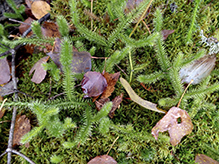 |
|||||
MinnesotaSeasons.com Photos |
|||||
Plant |
|||||
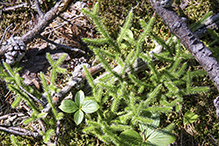 |
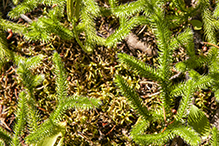 |
||||
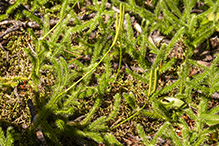 |
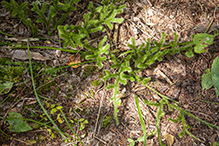 |
||||
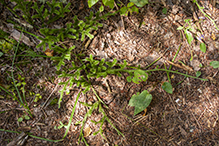 |
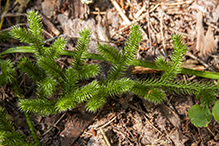 |
||||
Branches |
|||||
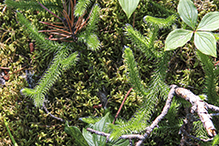 |
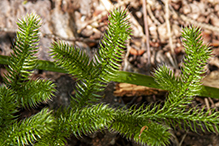 |
||||
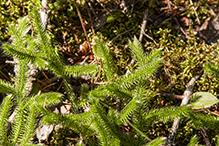 |
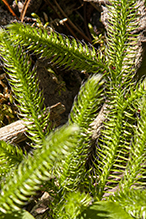 |
||||
Strobili |
|||||
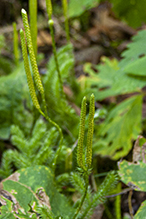 |
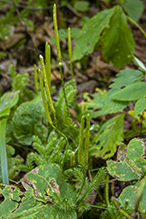 |
||||

Slideshows |
||

Visitor Videos |
|||
Share your video of this plant. |
|||
| This button not working for you? Simply email us at info@MinnesotaSeasons.com. Attach a video, a YouTube link, or a cloud storage link. |
|||
Other Videos |
|||

Created: 11/8/2019
Last Updated:
